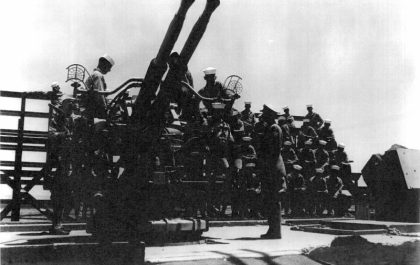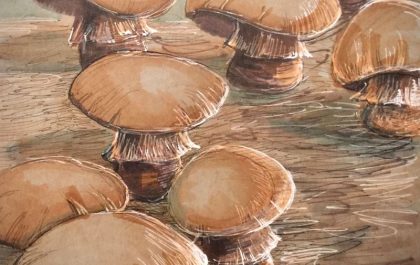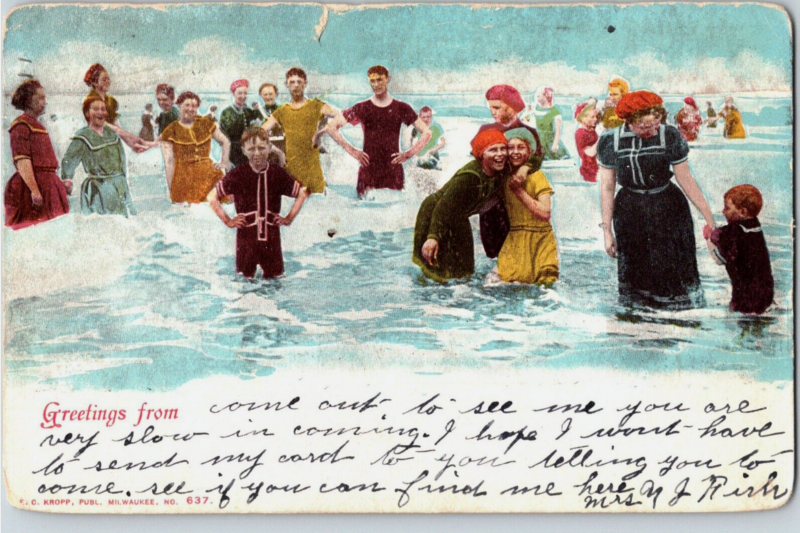
“A little sea-bathing would set me up forever,” pronounces Mrs Bennet in Jane Austen’s 1813 novel Pride and Prejudice, expressing the desire to spend the summer at the newly fashionable seaside town of Brighton. The author wasn’t opposed to a little sea bathing herself, but the fashion also provided prime material for her sharp pen and wit.
Sea bathing in Britain became popular in the late eighteenth century, when King George III was sent to the seaside for his health by Dr Richard Russell. The doctor moved to Brighton in 1753. The king and his brother, the Duke of Cumberland, joined him there, followed by the Prince Regent, who built his one-of-a-kind royal pavilion there and transformed what was previously a quiet fishing village into a thriving destination for the wealthy, who flocked to the coast to take “sea water cures.”
When Jane Austen was poking gentle fun at Brighton in Pride and Prejudice, watering places were all the rage, as a newly wealthy and secure upper middle class discovered the joys of traveling for pleasure and a day at the beach.
By the middle of the nineteenth century, rail travel had put holidays at the seaside in reach for a much wider cross section of the British population, but with a distinctly Victorian twist. Nature was all very well, but it needed to be controlled and kept in its place. If Mrs Bennet had got her wish, she would have worn what we regard as a nightgown—a long chemise—for sea bathing. Victorian beachgoers wore complicated wool garments—for women that meant a blouse, stockings, shoes and a cumbersome skirt. There was something indelicate about swimming, unless it was for one’s health. Salt water baths offered the health-giving benefits of the sea water without the inconvenience—and immodesty—of venturing out in public in one’s swim clothing. Intrepid Victorians who did want to swim in the ocean ventured there from the privacy of bathing machines—tent-like structures that offered a place to change and screened the bather from prying eyes—essential in a society so obsessed with modesty that the sight of an ankle turned heads and the legs of furniture were covered in ruffles, and never spoken of by name in polite society.
Those who didn’t care to bathe engaged in popular activities like taking the air, or collecting and pressing seaweed, but they also attended dances and concerts, and races and sporting events, ate exotic delicacies like seafood, and shopped for souvenirs. There was now an entire new economy in seaside towns based not on fishing or shipping but on tourism. New amusements were added to attract more visitors: pleasure piers with carousels and ferris wheels, grand hotels that catered to wealthy clientele, and boarding houses and self-catering cottages for the less well-to-do. Board walks were built to enable strollers to stay off of the sand. The beach itself became a venue for horse races, boxing matches and dance recitals. Somehow, along the way, the ocean was often lost from view in the proliferation of visitor-serving amenities.
It was this particularly Victorian form of beach going that arrived in the Santa Monica Bay in the mid nineteenth century. The Chumash and Tongva people had lived at the beach along the Santa Monica Bay for millennia. They had their own beach culture, one that evolved from an extensive understanding of seasons, weather, currents, and tides, one that didn’t require bath houses or bathing machines. The Spanish and Mexican colonists who displaced them in the early nineteenth century also didn’t require those things, but that was about to change with the influx of American settlers, after California became part of the United States.
In the 1860s, Santa Monica Canyon started to become a beach destination. Los Angeles County had grown from a population of around 3,530 in 1850, to 11,333 in 1860, and an increasing number of Angelenos began seeking respite from the summer heat of the city. The road to Santa Monica Canyon was a narrow, rutted cart track, and the accommodations consisted of canvas tents on the beach or on the bluff above it, but it was worth the hardships for a visit to the seaside. The land was part of the 6,656-acre Rancho Boca de Santa Monica Mexican land grant, owned by the descendants of Ysidro Reyes and Francisco Marquez, who acquired the property in 1839. The Reyes and Marquez families welcomed guests, or at least tolerated them, but they didn’t provide any amenities beyond access to the beach and to the year-round fresh water in the creek.
Why Santa Monica Canyon? Perhaps because it provided a natural break in the cliffs that line the beach for miles, and because it had year-round water, and genial owners who didn’t seem to mind uninvited guests.
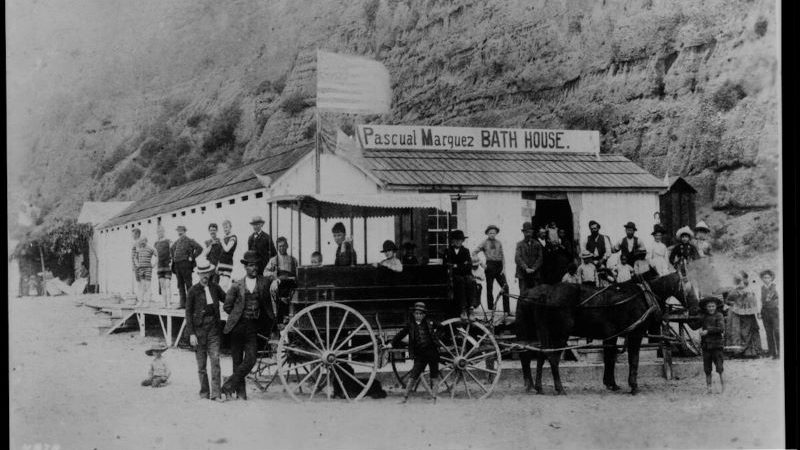
A saloon opened in the canyon in 1870. A year later, Santa Monica’s first hotel was built. Almost everyone who arrived in Los Angeles from elsewhere wanted to spend a day at the beach. The first rail line to Santa Monica, built in 1875, opened the way for easy access. In 1877, an entrepreneur named Michael Duffy opened a bathhouse on the beach below the hotel, at the bottom of what is now Chautauqua Boulevard. He named it for Pascaul Marquez, the son of Francisco Marquez, and appears to have built it on Marquez land, without the benefit of a deed or lease agreement.
The bathhouse was a modest building that offered sixteen small changing rooms with baths and showers, and bathing suits and towels that could be rented for the day. Adventurous patrons could swim in the ocean with the aid of a rope attached to a buoy anchored off shore. More timid souls, or those who were there seeking a salt water treatment for their ills, could bathe in seawater piped into a bathtub. This new business was served by a stagecoach that transported beachgoers from Los Angeles to the coast along what is now Washington Blvd. It was a popular attraction, and soon a ramshackle collection of shacks and tents sprang up around it, offering overnight accommodations, food, and even photographs.
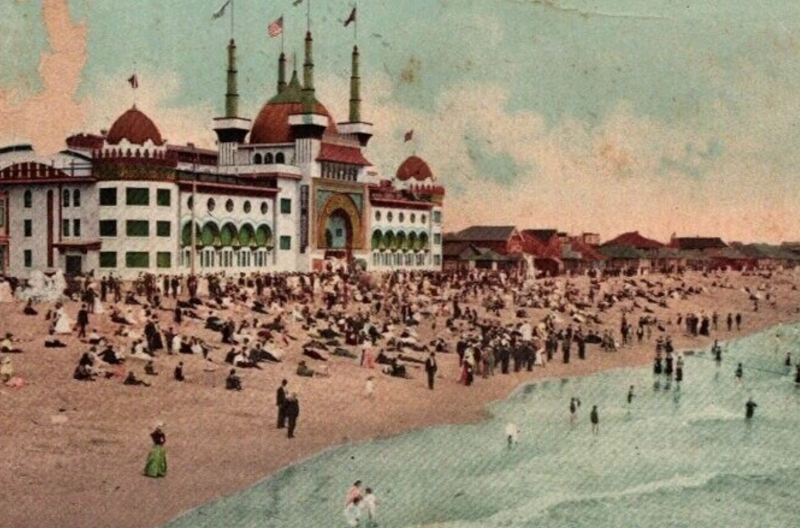
Duffy’s business was soon eclipsed by the Santa Monica Bathhouse, built in 1877 on land owned by John P. Jones and Robert Baker, Santa Monica town founders and would-be railroad tycoons who aspired to turn the Santa Monica Bay into the port of Los Angeles. The Santa Monica Bath House featured 25 rooms, a sun parlor, and separate steam rooms for men and women. It was replaced in 1894 by the much grander North Beach Bathhouse, which featured a salt water plunge (indoor pool) and was advertised as the “finest bath house” in Los Angeles. It was soon overshadowed by the spectacular Ocean Park Bath House, built in 1905. Its Moorish domes and minarets dominated the beach and the “plunge” or salt water swimming pool attracted big crowds.
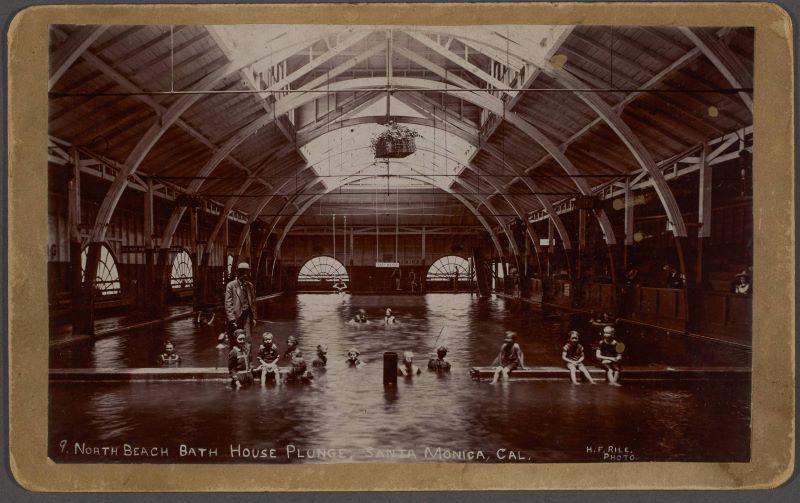
Even this massive structure was no match for the Redondo Beach Bathhouse, which opened in 1909 and was funded by railroad magnate Henry Huntington. It bristled with turrets, domes and cupolas, and was equipped with more than a thousand changing rooms, three salt water plunges, Turkish baths, and lavish lounges for men and women.
By then, bath houses were already being replaced by private beach clubs and luxury hotels that offered many of the same amenities with the advantage of also providing accommodations and exclusivity—anyone could go for a swim at a bathhouse for pocket change. Beach clubs ensured that only the elite and the elect had access.
Bath houses also had to compete with increasingly elaborate pleasure piers, offering all of the seaside attractions like rollercoasters and carousels that had made places like New York’s Coney Island a tourist destination on the East Coast. The Santa Monica Bay soon had an abundance of its own pleasure piers. The Santa Monica Pier, originally built for offshore sewage disposal, soon boasted rides like its still-celebrated carousel.
In Santa Monica, the beach was almost entirely lost from view behind all the businesses built to take advantage of visitors who longed for a day at the beach, but the advent of the automobile put the entire coastline within reach, not just the areas accessible trolleys or trains.
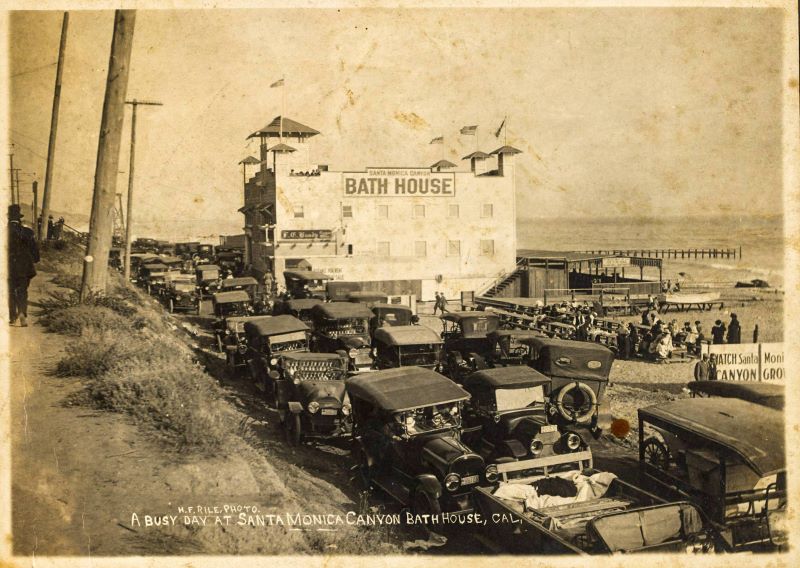
Car culture and beach culture evolved together. Instead of having a swimsuit and towel provided by the management of a bath house, anyone with access to an automobile had the freedom to pack a picnic, umbrella, and swimsuit, and find their own stretch of beach. The automobile put travel in reach for a much broader spectrum of the population, and car culture encouraged exploration.
One of those previously out-of-reach places was Topanga Beach. Before the advent of the automobile this beach could only be reached by stage coach, and was mostly the domain of the canyon homesteaders, who arrived in the Santa Monica Mountains after the United States took control of California from Mexico. They didn’t have time or energy for modern notions like vacations—amenities like electricity and running water wouldn’t arrive in many parts of the mountains until the 1920s and ’30s. A trip to the beach offered canyon residents a welcome break from what was often backbreaking labor. The influx of motorists from town offered opportunities for the locals to sell goods and services to visitors. A filling station and restaurant soon sprang up, catering to these new, mobile tourists.
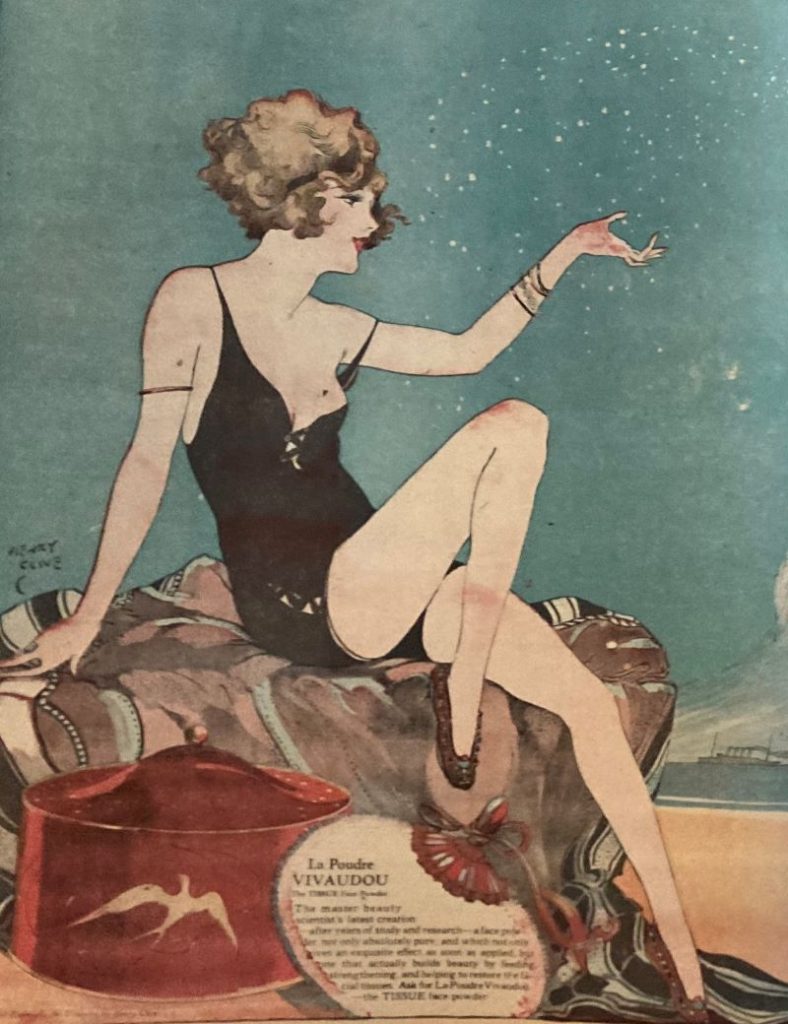
Modern beach culture emerged in the 1920s. As hems rose and necklines plummeted, women enjoyed the comfort of new one-piece swimsuits that, while still often made of wool, didn’t involve cumbersome skirts or stockings. The new styles of swimwear made it easier to actually swim. Instead of being scandalous, they became glamorous. Swimsuit-clad models were used to sell other products like cosmetics, and they also helped sell America on the idea of a day at the beach with a towel and a beach ball, not a bathhouse and a boardwalk.
Ocean swimming and surfing became increasingly popular during the 1920s. Motion picture stars helped popularize beach life. Myrna Loy was featured in ads selling swimwear. Clara Bow, the original “It Girl,” was shown on the beach in front of her Malibu Colony home with her surfboard. Olympians Duke Kahanamoku and Johnny Weissmuller made the jump from world class athletes to film and helped promote swimming as a sport and a leisure activity (men’s swimming was added to the Olympic Games only in 1896. Women athletes had to wait until the 1912 Olympics).
Kahanamoku devoted much of his time in California to teaching swimming and surfing skills, and he is even credited with bringing an early form of beach volleyball to Santa Monica from Hawaii when he became athletic director at the Beach Club.
It wasn’t a picnic for everyone. Restrictive laws in many areas attempted to prevent people of color from equal—or any—access to the beach. Santa Monica was one of the few locations where beach access was available for African Americans, although by the 1920s, it was just a two-hundred-foot section between the west end of Pico Boulevard and Bicknell Street, referred to as “Inkwell Beach.”
Other people also found themselves increasingly shut out of the beach, as private clubs and exclusive housing developments put the ocean out of reach. By the 1920s, the decade when beach culture began to evolve into its current form, houses were already beginning to line the bay in Santa Monica and along Topanga Beach and parts of Malibu.
The Los Angeles County board of supervisors eventually figured out that there was a demand for public beaches and a diminishing amount of undeveloped oceanfront. In 1941, the county acquired 1.8 miles of beach at Zuma Beach, after the Marblehead Land Company—created by May Rindge, the last sole owner of the old Spanish land grant property that is now the city of Malibu—defaulted on property taxes.
Shortly after the beach became public, it was put off limits by the military for the duration of WWII. The first county lifeguards assigned to Zuma didn’t arrive until 1945. The beach crowds didn’t begin to show up until the 1960s.
Will Rogers Beach also became public in 1945, donated to the state by humorist and radio personality Will Rogers, but beach acquisition stalled during the 1950s and 60s. When it resumed, it was controversial. At Topanga State Beach, much of the land was acquired by eminent domain—a gain for the public but a painful loss for beach homeowners. That’s true of Westward and Nicholas beaches, as well. The state also acquired two miles of Santa Monica beach, sandwiched between Will Rogers and county-owned Venice Beach, and beach access was not a guaranteed right until the California Coastal Act was voted into law in 1976, ensuring that almost all California beaches—even the ones in front of private property—can be accessed by the public. Today, there are 30 miles of public beach in Los Angeles County, from Nicholas Canyon in Malibu to White Point in San Pedro. Not all of that coastline is easily accessible or pleasant to visit, but there are miles of clean, safe, beaches with lifeguards, restrooms, and parking. And because of the Coastal Act, everyone in California has the right to the beach, not just the wealthy and privileged who can afford to live by it.
Beach culture continues to define the communities that line the Santa Monica Bay. It’s a culture that continues to evolve, and one that faces new threats from climate change, sea level rise, development pressures, and the dynamic natural processes that are always at work, but it remains a major part of the California dream.
